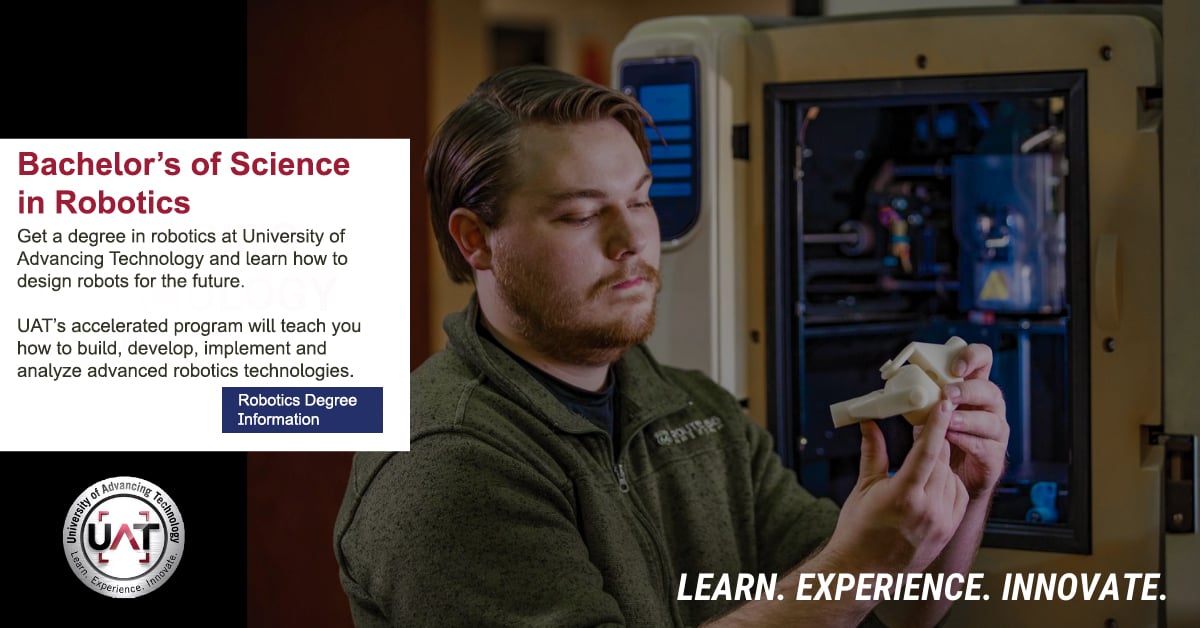Robotics and Embedded Systems Education
Robots may not be taking over the world (yet), but the field of robotics does present an exciting opportunity to learn more about robots, AI and their application to our human world.
As a technology-heavy degree, Robotics and Embedded Systems focuses on how robots work, how to build them and how to use them to improve our everyday lives. And the projected salary for Robotics majors isn’t bad either!
In this guide, we are covering what Robotics and Embedded Systems is, why a degree might be worth it and how to get started in the field of Robotics.
What are "Robotics and Embedded Systems"?
A Robotics and Embedded Systems degree prepares students to work with systems that combine hardware and software to perform functions or tasks. “Robots” are mainly mechanical devices and hardware, whereas “embedded systems” usually serve a specific functionality and are embedded into an existing device.
Robots and embedded systems often work together as well as independently. In either case, highly skilled professionals are needed to make these devices and systems work effectively.
Is Robotics a Good Career?
According to a study conducted by RoboticsTomorrow.com, robotics engineers are not only highly compensated, but they are also some of the happiest professionals in the STEM fields. When surveyed, robotics engineers rated their field an average of 4.2 out of 5, which puts them in the top 4% of all careers!
There are a few reasons why robotics is a great career:
- High salary
- Great utilization of skills
- High work satisfaction
- Vast job prospects
- 9% job growth (2016-2026)
What Jobs Can You Get with a Robotics Degree?
There are a wide variety of jobs you can get with a robotics degree or STEM degree with a robotics focus. Your opportunities are not limited to full-time employment, either; many robotics engineers go on to work for themselves as freelance researchers or inventors.
Top 5 Robotics Careers:
- Mechanical Engineer – Average Salary: $90,160 per year
- Software Engineer – Average Salary: $110,140 per year
- Computer Hardware Engineer – Average Salary: $119,560 per year
- User Experience (UX) Designer - Average Salary: $85,490 per year
- Data Scientist – Average Salary: $103,930 per year
Job Marketing For Robotics Engineers
The demand for robotics engineers is growing – and it pays well!
According to Sokanu, the job market is expected to increase by 6.4 percent between 2016 and 2026.
Plus, over the next 10 years, the United States will need over 12,500 new roboticists in the field.
“The demand for automation and robotics will continue to fuel these high paying jobs, and we expect this to continue for the next 20 years.” – Dr. Jill Coddington, Program Champion of Robotics & Embedded Systems
Robotics-Related Degrees in STEM
While a degree in Robotics and Embedded Systems is certainly interesting and worthwhile, it’s important to know that there are related degrees one can pursue if they are interested in creation and simulation technology. At University of Advancing Technology (UAT), we offer several degrees for those looking to learn more about robotics, digital maker and fabrication, human computer interaction (HCI) and virtual reality.
Digital Maker and Fabrication
A Digital Maker and Fabrication degree prepares students to design, build and apply new technological devices. It combines user-centric design theory with a variety of skills, including programming, parametric modeling, kinematics, 3D manufacturing and more.
Human Computer Interaction
The Human Computer Interaction Degree involves the real world application of computer technologies, intelligent interfaces, virtual and augmented reality and new I/O devices. Students in this program develop use cases for software and devices, create virtual environments and develop integrated digital assets.
Virtual Reality
A Virtual Reality Degree applies the design principles of gaming to real-life applications. This may include use cases for corporate training, medical and therapy, military and education and more. Students are exposed to all the tools of the games profession and will develop programming and asset creation skill sets.
How to Become a Robotics Engineer
Becoming a roboticist follows a similar path as most other STEM fields: application, education, experience and job searching.
Here is the general process for how to become a robotics engineer:
Step 1 - Apply to a robotics program
Search for a reliable and accredited robotics program to learn the fundamentals of robotics engineering.
A holistic, thorough education is your best bet for obtaining the skills you need to become a marketable robots expert. You can apply for a program during high school, after undergrad, or at any stage of your life.
Step 2 - Graduate from robotics program
Once you’ve completed your degree, you should have a thorough understanding of how robots work, how to design devices, how to create systems and how to apply them to real-world scenarios. The fundamentals will get you far, but honing your skills and gaining hands-on experience will take you to that next level.
Step 3 - Obtain hands-on experience
UAT offers a variety of apprenticeship and internship opportunities to help students gain hands-on experience. This is where you can apply what you’ve learned.
Step 4 - Apply for robotics jobs
There are a wealth of job opportunities for robotics majors.
To help in your search, most colleges and universities provide career counseling, host job fairs and have job boards that list job openings.
Some other places to look for robotics jobs include:
-
-
- Indeed
- Local career fairs
- ZipRecruiter
- Glassdoor
-
Get a Robotics and Embedded Systems Degree at UAT
UAT offers a complete Robotics and Embedded Systems degree to prepare students to enter the field of robotics. Students will learn to use robotics technology, design digital hardware, learn software programming and more.
Our students will have the ability to build, develop, implement and analyze advanced robotics technologies. This prepares them for a successful career in the electronic and robotics industry.
Learn more about our programs and apply today to get started!







Comment